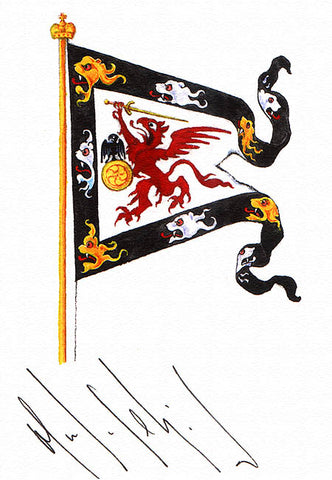Heraldic Flags and Standards part 1

One of the most evocative symbols is that of the flag or standard. Such objects of attention are as old as history itself. Flags have borne heraldic symbols since the advent of heraldry. Heraldic designs appear on the Bayeux Tapestry on the flags and pennants of the Flemish contingent in Duke William’s army. On the opposing side King Harold’s standard-bearer displays the “wyvern” or two-legged dragon of Wessex. The lance pennants of the Normans and Flemish at the Battle of Hastings in 1066 were made of cloth but it would seem that the standard of Wessex was carved in metal or wood. Whatever the materials, both armies at the Battle of Hastings made use of flags of some sort and they were almost certainly meant as objects of veneration, for both individuals and for entire army units.
 One particular type of the flag, the banner, gave its name to a class of medieval military men, the knights banneret, or bannerets for short. These high-ranking commanders were able to bring a body of men to a battle under their own banner- a square or oblong flag bearing the knight’s own Coat of Arms. In the 12th and 13th centuries the banner had a width one third of its length, later in the Middle Ages it became square in shape. The banner was a most important indicator to the troops of their commander’s presence on the battle-field. Held high above the banneret’s head , the banner went wherever he did, and the two were never separated, unless the banner-bearer was killed in action. Two other types of heraldic flag were popular with the knightly class. One was the pennon, a triangular flag that could bear either Coat of Arms or a badge. The other was the standard, a long tapering flag, larger than the pennon, which could have a split or rounded end. Instead of the bearer’s Coat of Arms, the standard usually displayed the badge or device of the bearer. This could appear once or several times and would often by accompanied by the motto or cri-de-guerre (battle-cry). The “hoist” of the standard (the area at the top of the flag close to the pole) tended to bear the national device, for example the Cross of St. George for English knights. The main background of the standard was made up of the livery colors of the bearer. The medieval English standard was larger than the other flags, and its size varied with the owner’s rank. The Cross of St. George usually appeared next to the staff, and the rest of the field was generally divided per fess (horizontally) into two colors, in most cases the livery colors of the owner. "With some principal figure or device occupying a prominent position, various badges are displayed over the whole field, a motto, which is placed bend-wise, having divided the standard into compartments. The edges are fringed throughout, and the extremity is sometimes swallow-tailed, and sometimes rounded
One particular type of the flag, the banner, gave its name to a class of medieval military men, the knights banneret, or bannerets for short. These high-ranking commanders were able to bring a body of men to a battle under their own banner- a square or oblong flag bearing the knight’s own Coat of Arms. In the 12th and 13th centuries the banner had a width one third of its length, later in the Middle Ages it became square in shape. The banner was a most important indicator to the troops of their commander’s presence on the battle-field. Held high above the banneret’s head , the banner went wherever he did, and the two were never separated, unless the banner-bearer was killed in action. Two other types of heraldic flag were popular with the knightly class. One was the pennon, a triangular flag that could bear either Coat of Arms or a badge. The other was the standard, a long tapering flag, larger than the pennon, which could have a split or rounded end. Instead of the bearer’s Coat of Arms, the standard usually displayed the badge or device of the bearer. This could appear once or several times and would often by accompanied by the motto or cri-de-guerre (battle-cry). The “hoist” of the standard (the area at the top of the flag close to the pole) tended to bear the national device, for example the Cross of St. George for English knights. The main background of the standard was made up of the livery colors of the bearer. The medieval English standard was larger than the other flags, and its size varied with the owner’s rank. The Cross of St. George usually appeared next to the staff, and the rest of the field was generally divided per fess (horizontally) into two colors, in most cases the livery colors of the owner. "With some principal figure or device occupying a prominent position, various badges are displayed over the whole field, a motto, which is placed bend-wise, having divided the standard into compartments. The edges are fringed throughout, and the extremity is sometimes swallow-tailed, and sometimes rounded











